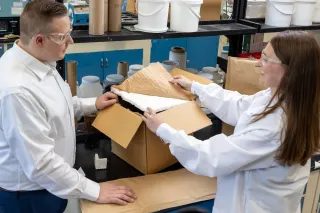VTTers are creating a passive cooling solution to mitigate climate change. “Our solution is an energy-saving weather-adaptive window film that enables passive cooling or heating in living spaces. Our solution is based on renewable plant-derived nanocellulose and can be used as a film or a coating”, says Aayush Jaiswal, Research Scientist and team’s Project Manager from VTT.
Climate change is causing more and more heat-induced health problems around the world. This leads to a growing need for cooling solutions. Active cooling, for example air conditioning, uses large amount of electricity which contributes to carbon emissions, thus, worsening the problem. This calls for the increased use of passive (powerless) cooling technologies to support the active cooling systems. The CoolCellulose project, which is a part of VTT’s iBEX innovation programme, explores nanocellulose, a plant-derived nanomaterial, as a passive cooling solution.
There are commercially available window films and solar glasses for blocking sunlight and providing passive cooling. The novelty is that the CoolCellulose team is creating a weather-adaptive material. Their film could help to cool a building in the summer and to keep it warm in the winter, adapting automatically to the weather. This could save energy throughout the year unlike purely cooling solutions.
“Our solution would not replace active cooling or heating systems. Rather, it would complement them and reduce the need for electricity, especially during the peak hours where the grid can get overloaded. An adaptive system is particularly interesting in environments where large seasonal temperature differences occur”, Aayush Jaiswal explains.
CoolCellulose team members: Ari Hokkanen, Vinay Kumar, Aayush Jaiswal and Anniina Savolainen.

Enhancing nanocellulose with thermochromic particles
The team uses nanocellulose for manufacturing their film. The weather-adaptive feature is imparted to the film by doping it with special thermochromic particles.
“We are using particles that are designed to switch their optical properties above a desired temperature. In addition, we apply an ultrathin reflective coating on one side of the film. So, the film acts as a mirror when exposed to bright sunlight in hot weather, helping cool the indoor space. However, in cold weather, the film absorbs solar radiation and helps heat the space. The adaption temperature can be tuned as needed.”
The CoolCellulose concept has been developed within VTT’s iBEX innovation programme by bringing together experts from materials science, photonics, and computational modelling. The team has been able to manufacture the films in a laboratory scale. This has required expertise on nanocellulose materials as well as photonics and optical measuring.
Estimated cooling potential up to 5°C
The CoolCellulose team has carried out both lab and outdoor experiments and built a simulation model to demonstrate the potential impact of the solution.
“To demonstrate the impact of the solution, we have made thermal measurements in the lab-scale using a solar lamp which mimics the solar radiation. We were able to observe approx. 5 degrees Celsius cooling potential”, Jaiswal mentions.
The team has built a computation model for simulating the performance of the solution. This allows the team to study the potential impact globally in different locations and weather conditions, without making field experiments everywhere.
“For example, with outdoor temperature of 35 degrees Celsius, I would expect to cool down a room with a sun-facing window by up to 5 degrees Celsius. This is important: even a difference of 1 degree saves about 5% of energy in a big building”, Jaiswal points out.
Members of the CoolCellulose team are VTT’s Senior Scientist Vinay Kumar and Research Scientist Aayush Jaiswal, experts on bio-based sustainable materials, as well as VTT’s Research Scientist Ari Hokkanen, expert on photonics and optical measurements. The simulation expert is VTT’s Research Scientist Sergei Khakalo. Research Assistant Anniina Savolainen and Senior Scientist Tapio Mäkelä also from VTT take part in cellulose film preparation.
Analysis of a CoolCellulose sample at VTT.

Aayush Jaiswal presents one of the CoolCellulose samples.

Cool-Cellulose sample









